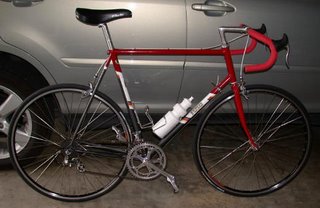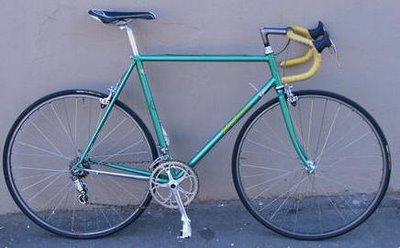Why did I quit riding, and why am I about to start up again?
 Mon, June 26, 2006
Mon, June 26, 2006 This was a question asked of me recently. When I left the bike business in 1993 I also scaled down my lifestyle and got rid of most of my possessions, even my bike. I moved into a small studio apartment and there was no room for a bike.
I took up running to stay in shape; I found if I ran for 30 or 45 minutes I could get a good work out. On a bike my ride would take much longer than this, so running gave me more time for other things.
I am no stranger to running; in the 1970s when I lived in England my chosen sport was cyclo-cross. For those non biking readers of this blog; cyclo-cross is the winter sport of cycling and basically you find a course that is un-ridable on a bicycle and you hold a bike race on it. Riding cross country on grass and mud, and when the terrain gets too hard to ride you dismount and run with the bike on your shoulder.
Cyclo-cross suited me for several reasons. During the summer I was busy building frames and had no time to train and race. The cyclo-cross season ran from October to February and as training I could get by running five miles each evening, and riding cyclo-cross at weekends.
In 1970 while on a training ride at night I was hit head on by a motorcycle taking a corner on the wrong side of the road. My right fore-arm was shattered in three pieces and I still have a stainless steel plate in my arm to this day. My arm was in a cast for five months; after that I was a little wary of riding in the dark.
Cyclo-cross events are usually held on a circular course about a mile in length. You race for one hour plus a lap. The slower riders will be lapped by the faster riders several times during the race, but each rider has the number of laps counted, and at the end of an hour a bell is sounded and everyone does one more lap.
One hour cyclo-cross is the equivalent of eighty miles on the road in terms of effort and energy expended. Pros and amateurs rode in the same event and some of the bigger events would have riders from France, Belgium, and Switzerland competing. I did alright in cyclo-cross; became skilled in the many techniques required of the sport like dismounting and mounting the bike without stopping, and because of this I could beat riders who were younger and fitter than me.
So this is why I have no problem with running or rather I didn’t until about three years ago when my hip started to give me trouble. I had to give up running and take up walking. Now walking doesn’t do it for me anymore; I walk as far as twelve miles taking three hours which is too much time out of my day. So time to get back on the bike again.
I bought a Fuso frame recently that I built in 1986; figured I better get one before they got too expensive. A good friend of mine sent me enough components to build it up; all Campagnolo SR from the 1980s; I’m just short a bottom bracket, but one is on its way to me now so watch this space for updates and pictures.
 Dave Moulton | Comments Off |
Dave Moulton | Comments Off | 





















